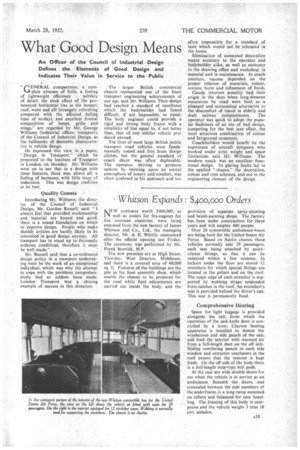What Good Design Me ans .
Page 53

If you've noticed an error in this article please click here to report it so we can fix it.
r ENERAL compactness, a com plete absence of frills, a feeling of lightweight efficiency . subtlety of detail, the sleek effect of the pronounced horizontal line in the bonnet, roof, waist and sill (strangely refreshing compared with the affected falling lines of to-day), and excellent frontal composition of lamps, grille and wings," are regarded by Mr. George Williams (industrial officer, transport), of the Council of Industrial Design, as the hallmarks of desirable characteristics, in vehicle design.
He expressed this view in a paper, " Design in Transport," which he presented to the Institute of Transport in London, on Monday. Mr. Williams went on to say that in a design with these features, there was, above all, a feeling of harmony, with little trace of indecision. This was design tradition at its best.
Quality Counts
Introducing Mr. Williams, the director of the Council of Industrial Design, Mr. Gordon Russell. said: " always feel that provided Workmanship and material are honest and good, there is a sound foundation on which to improve design. People who make shoddy articles are hardly likely to be _interested in good design anyway. All transport has to stand up to extremely arduous conditions, therefore it must be well made."
Mr. Russell said that a co-ordinated design policy in a transport undertaking must be the work of an exceptional individual, which was why the attempt to cope with the problems comprehensively had so seldom been made. London Transport was a shining example of success in this direction.
The larger British commercial chassis represented one of the finest transport engineering achievements of otir age, said Mr. Williams. Their design had reached a standard of excellence which the bodybuilder had found difficult, if not impossible, to equal. The body engineer could provide a rigid and strong body frame with a simplicity of line equal to, if not better than, that of:any similar vehicle produced abroad.
The lines of.most large British public transport road vehicles . were fundamentally sound and free from design cliches, but the general standard. of coach' decor was often deplorable. The operator, striving to promote custom by insisting . upon an unreal atmosphere of. luxury and.comfort, was often confused inhis approach and too
often responsible for a standard of taste which would not be tolerated in the home.
Elimination of unwanted decoration meant economy to the operator and bodybuilder alike, as well as economy in the drawing office and workshop, in material and in maintenance. In coach interiors, success depended on the proper relation of materials, colour, texture, form and refinement of finish.
Gaudy interiors possibly had their origin in the days when long-distance excursions by road were held as a pleasant and economical alternative to the discomfort of travel in elderly and drab railway compartments. The operator was quick to adopt the popular flashiness of an era of bad design, competing for the best jazz effect, the most atrocious combination of colour and fairground ornament.
Coach builders would benefit bythe experience of aircraft designers who worked under strict weight and -space limitations, said Mr. Williams. The modern coach was an excellent functional design. Its glaring faults lay in the applied " shapes," the decoration, colour and trim schemes, and not in the engineering element of the design.




















































































